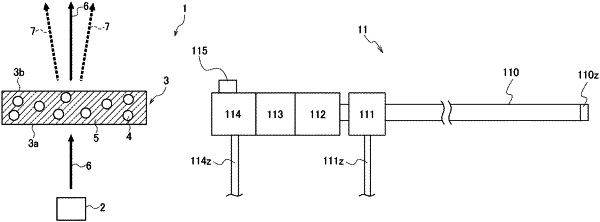| CPC F21V 9/30 (2018.02) [A61B 5/0071 (2013.01); A61N 5/062 (2013.01); A61N 5/067 (2021.08); A61B 1/043 (2013.01); A61B 1/0653 (2013.01); F21W 2131/20 (2013.01); F21Y 2115/30 (2016.08)] | 17 Claims |

|
1. A light-emitting device comprising:
a light source that radiates a primary light; and
a first phosphor that absorbs the primary light and converts the primary light into a first wavelength-converted light having a longer wavelength than the primary light, wherein:
the first wavelength-converted light includes fluorescence based on electron energy transition of Cr3+, the fluorescence having an afterglow of more than 10 μs based on a parity-forbidden transition,
a fluorescence spectrum of the first wavelength-converted light has a maximum fluorescence intensity value in region of a wavelength exceeding 710 nm, and
the light source is a solid-state light-emitting element with a rated light output of 1 W or more, wherein saturation of the fluorescence based on the parity-forbidden transition of Cr3+ is less likely to occur under excitation by the primary light relative to saturation of fluorescence based on a parity-allowed transition of Ce3+ or Eu2+ having an afterglow of 10 μs or less.
|